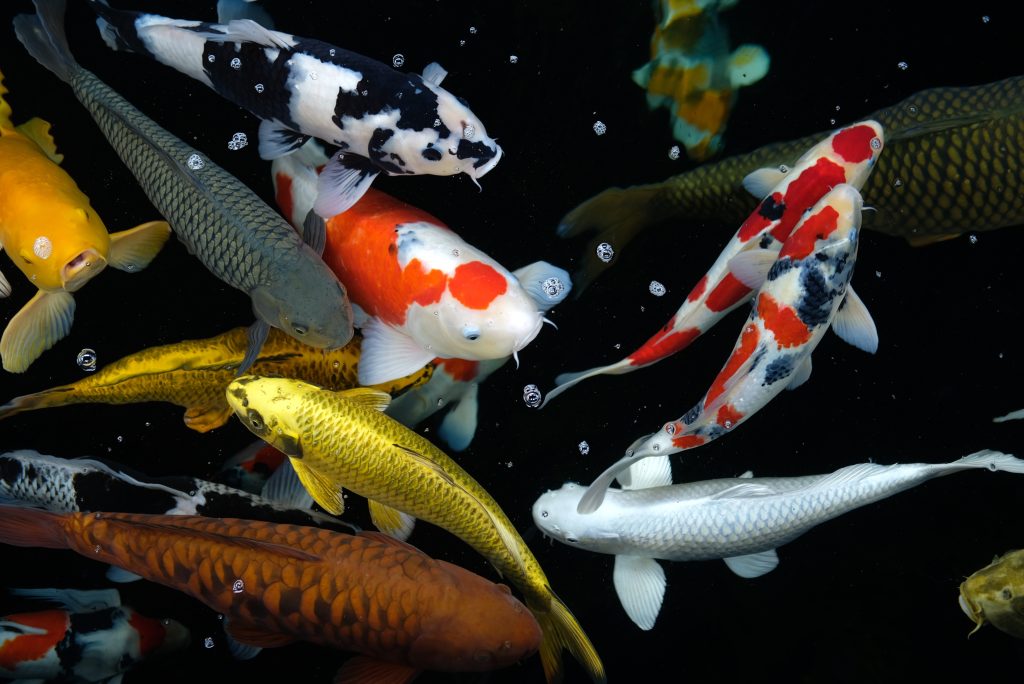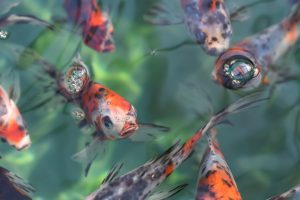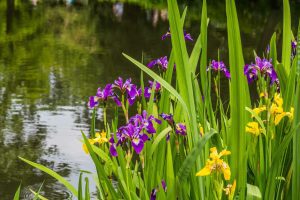
Koi Varieties - The Ultimate Guide: Exploring Japan's Living Jewels
Koi fish are beautiful and captivating ornamental creatures that have fascinated people for centuries. These colourful carp come in a wide array of stunning varieties, each with its own unique patterns and hues.
Koi varieties encompass a great number of different types, ranging from the classic Kohaku to more exotic breeds like the Ginrin and Doitsu.

For both newcomers and experienced koi keepers, understanding the different varieties can be a bit overwhelming.
There’s a vast amount of information to absorb, and the sheer number of varieties can be daunting.
But learning about these different types is key to fully appreciating the beauty and diversity of koi.
In this guide, we’ll explore the fascinating world of koi varieties. We’ll look at some of the most popular types, their distinguishing features, and what makes each one special.
Whether you’re a long-time koi enthusiast or just starting to dip your toes into the hobby, this guide will help you gain a deeper appreciation for these magnificent fish.
Key Takeaways
- Koi come in numerous varieties with unique patterns and colours
- Understanding koi types enhances appreciation of their beauty
- Proper care is crucial for maintaining healthy and vibrant koi
Understanding Koi and Their Significance

Koi fish have a rich history and deep cultural meaning. These colourful carp have captured hearts worldwide with their beauty and symbolism.
Origin and History
Koi, also known as nishikigoi, began as common carp in China. They made their way to Japan in the 1800s.
Japanese farmers first bred them for food. Over time, they noticed some carp had unique colours.
These special fish caught people’s eyes. Farmers started to breed them for their looks. This led to many new colour patterns.
By the early 1900s, koi became popular pets.
Today, there are over 100 koi varieties. Each has its own mix of colours and markings. Breeders work hard to create new and exciting types.
Cultural Importance
Koi hold great meaning in Japanese culture. They stand for good luck, success, and strength. Many see them as symbols of overcoming hard times.
In Japan, koi often appear in art and stories. They’re part of many festivals too. Some people even give koi flags as gifts for Children’s Day.
Koi’s fame has spread beyond Japan. Now, people all over the world keep them as pets.
Many enjoy watching them swim in garden ponds. Others take part in koi shows and contests.
These ornamental fish bring beauty and calm to many homes. Their gentle nature and long lives make them beloved pets.
Fundamentals of Koi Varieties
Koi varieties are classified based on their colours and patterns. Understanding these basics helps koi enthusiasts appreciate and identify different types.
The Classification System
Koi varieties are grouped into categories based on their primary colours and markings.
The three most prestigious varieties are known as Gosanke, which includes Kohaku, Taisho Sanke, and Showa Sanke.
Kohaku koi have a white body with red patterns. Taisho Sanke are similar but add black markings. Showa Sanke have a black base with red and white patterns.
Other important groups include Utsurimono, which have a solid-coloured body with black markings, and metallic koi with shimmering scales.
The classification system helps breeders and judges assess koi quality. It considers factors like colour intensity, pattern symmetry, and body shape.
Recognising Different Varieties
To identify koi varieties, one must look at their colours, patterns, and scale types.
Kohaku koi are easily recognised by their white body and red markings. The red should be vivid and well-defined.
Taisho Sanke add black spots to the Kohaku pattern. These spots should be balanced and not overlap with the red markings.
Utsurimono varieties come in different base colours. The most common are Ki Utsuri (yellow), Hi Utsuri (red), and Shiro Utsuri (white), all with black markings.
Scale types also play a role in identification.
Some koi have regular scales, while others have mirror scales or are scaleless. These features add to the uniqueness of each variety.
The Major Varieties of Koi
Koi come in many striking colours and patterns. The most popular varieties feature bold contrasts and eye-catching designs. Each type has unique characteristics that set it apart.
Kohaku
Kohaku koi have a white body with red markings. The white should be pure and unblemished. The red patches, called hi, can vary in size and shape. Good kohaku have crisp edges between the red and white.
Breeders aim for balanced patterns. The hi may form stepping stones along the back or wrap around the body. A red patch on the head is prized.
Quality kohaku have deep, vibrant red that doesn’t fade. The white base should be porcelain-like. Judges look for clean colours without stray scales.
Sanke
Sanke koi add black accents to the kohaku pattern. They have a white body with red and black markings. The black, called sumi, appears as spots or short streaks.
Ideal sanke have balanced colour placement. The sumi shouldn’t overwhelm the red. It often sits along the back and sides.
Good sanke display crisp edges between all three colours. The sumi should be jet black. Breeders aim for sumi that appears to sit on top of the scales.
Showa
Showa koi have a black base with red and white markings. They often look darker overall than sanke. The black, red, and white should be evenly balanced.
Quality showa have deep, lacquer-like black. The red and white pop against this dark background. Patterns vary but typically wrap around the body.
Showa can change dramatically as they age. The black may recede, revealing more white. This can improve their appearance over time.
Utsuri
Utsuri koi have a solid base colour with contrasting markings. The most common are:
- Shiro utsuri: Black base with white markings
- Hi utsuri: Black base with red markings
The markings should be bold and well-defined. They often form a zig-zag or lightning bolt pattern along the sides.
Good utsuri have a glossy black base. The contrasting colour should be bright and clean. Judges look for balance in the pattern.
Bekko
Bekko koi have a solid base colour with black spots. The three main types are:
- Shiro bekko: White base
- Aka bekko: Red base
- Ki bekko: Yellow base
The black spots should be small and well-spaced. They’re typically confined to the back and sides. Bekko patterns are simpler than utsuri.
Quality bekko have a clean base colour. The spots should be jet black and crisp. Too many spots can make the koi look cluttered.
Distinguishing Features of Koi

Koi fish are known for their striking looks. They come in many colours, scale types, and body shapes. These traits help tell different koi types apart.
Colour Patterns
Koi sport a wide range of vibrant colours. The Kohaku variety has a white body with red markings. Goshiki koi display five colours: red, white, black, dark blue, and light blue. Chagoi koi are solid brown or grey, often with a soft, velvety look.
Some koi have metallic scales that add a shimmery effect. The Matsuba koi has a base colour with black spots on each scale, creating a pine cone pattern.
Colour patterns can be simple or complex. Some koi have solid colours, while others show intricate designs. The placement of colours on a koi’s body is key in judging its quality.
Scale Types
Koi scales come in different styles. The most common is the fully-scaled type, where scales cover the whole body.
Doitsu koi have few or no scales, giving them a smooth look.
Ginrin koi have scales with a sparkly effect. These scales catch the light and make the fish shine. The ginrin trait can appear on many koi types, adding extra flair.
Some koi have a mix of scale types. For example, a fish might have normal scales on its body but no scales on its head. This adds to the koi’s unique look.
Body Shapes
Koi body shapes can vary quite a bit. The ideal shape is often described as torpedo-like. This means the body is long and streamlined, with a tapered head and tail.
Some koi have a more round body shape. Others might be slimmer or have a flatter profile. The fins and tail also play a role in the overall shape.
A koi’s body shape can affect how it swims and moves in the water. Judges often look at body shape when rating koi in shows. A good shape shows the koi is healthy and well-bred.
The Lustrous Hikari Varieties

Hikari koi are known for their stunning metallic sheen. These fish stand out in any pond with their eye-catching, reflective scales that shimmer in the sunlight.
Metallic and Shimmery Scales
Hikari koi have a unique genetic trait that gives them their metallic appearance. Their scales contain special pigments that reflect light, creating a dazzling effect.
This shimmery quality makes them highly prized by koi enthusiasts.
Hikari koi come in various colours and patterns. The metallic sheen can enhance traditional koi patterns, adding an extra layer of visual interest.
Some popular hikari varieties include Kin Showa, Gin Shiro, and Kin Ki Utsuri.
The lustre of hikari koi can vary. Some have a subtle shimmer, while others display a bold, mirror-like finish.
Breeders work hard to create koi with strong hikari traits and deep, rich colours.
Ogon and Hikarimono
Ogon koi are a subset of hikari varieties. These fish have a solid metallic colour covering their entire body. Platinum Ogon koi, with their bright silver scales, are particularly striking.
Hikarimono is a term for metallic koi with patterns. Hariwake koi are a popular hikarimono variety, featuring a metallic base with contrasting patterns.
Ogon and hikarimono koi require special care to maintain their lustrous appearance. Clean water and a balanced diet are essential for keeping their scales healthy and shiny.
These fish can be more sensitive to changes in water quality than non-metallic varieties.
Lesser-Known but Captivating Varieties
Koi enthusiasts often seek out unique and rare varieties to add diversity to their ponds. These lesser-known types offer stunning patterns and colours that can captivate onlookers.
Goromo and Goshiki
Goromo koi feature a white base with red markings outlined by a lace-like pattern. This intricate design makes them stand out in any collection.
Breeders developed Goromo through selective breeding, resulting in subtypes like Ai Goromo and Budo Goromo.
Goshiki koi display a mix of five colours: red, white, black, blue, and dark blue. Their name means “five colours” in Japanese.
These fish often have a blue or grey base with red, black, and white markings. Goshiki koi combine traits from Asagi and Utsuri varieties, creating a dynamic appearance.
Tancho and Shusui Types
Tancho koi are named after Japan’s red-crowned crane. They feature a single red spot on their head, resembling the crane’s distinctive marking.
Popular Tancho subtypes include:
- Tancho Kohaku: White body with a red head spot
- Tancho Sanke: White body with black markings and a red head spot
Shusui koi have a striking appearance with large, mirror-like scales along their backs. They often display a blue dorsal fin and red or orange markings on their sides.
Shusui are a scaleless variety, except for the prominent line of scales on their back.
Specialty Koi Varieties
Specialty koi varieties showcase unique features and patterns. These fish offer collectors rare and sought-after options beyond traditional types.
Doitsu Varieties
Doitsu koi have fewer scales than standard varieties. They display smooth, scaleless skin with rows of large scales along their backs and sides. This trait gives them a striking look.
Doitsu koi come in many colours and patterns. Popular types include Doitsu Kohaku and Doitsu Sanke.
Their reduced scales make their colours appear more vibrant.
Doitsu varieties need extra care. Their lack of scales makes them more prone to injury.
Pond owners must ensure smooth surfaces and gentle handling.
Kawarimono and Unique Crosses
Kawarimono refers to rare or unusual koi varieties. These fish often result from crossing different types. They display unique colour combinations and patterns.
Kujaku koi are a prime example. They have a white base with red, black, and metallic overlay.
Kikusui koi feature a white body with red markings and no scales.
Kanoko koi, also known as “fawn” koi, show a speckled pattern. This gives them a distinctive, spotted appearance. These rare varieties often fetch high prices among collectors.
Caring for Koi
Proper koi care requires creating the right environment and providing good nutrition. These elements are key to raising healthy, vibrant koi fish.
Creating an Ideal Koi Pond
A well-designed koi pond is crucial for the fish’s wellbeing. The pond should be at least 1.5 metres deep, with a volume of 3,000 to 4,000 litres per koi.
This depth allows koi to dive and protects them from predators.
Good filtration is essential. A quality filter system removes waste and keeps water clean. Aim for a flow rate that turns over the entire pond volume every hour.
Koi ponds need proper aeration. Install an air pump or waterfall to ensure adequate oxygen levels.
This is especially important in warm weather when oxygen levels drop.
Include plants in your pond design. They provide shade and help maintain water quality. Water lilies and lotus are excellent choices.
Nutrition and Health
Feeding koi a balanced diet is vital for their health and colour. High-quality koi food should form the base of their diet. Look for foods with 30-35% protein content.
Vary their diet with treats like fruits and vegetables. Oranges, watermelon, and lettuce are good options.
Feed small amounts to avoid overfeeding.
Monitor your koi’s health regularly. Look for signs of illness such as lethargy, loss of appetite, or unusual swimming patterns.
Quarantine new fish before adding them to your pond to prevent disease spread.
Maintaining water quality is crucial for koi health. Test pH, ammonia, and nitrite levels weekly.
Keep pH between 7.0 and 8.6. Ammonia and nitrite should be at 0 ppm.
Breeding Koi
Breeding koi involves careful selection of parent fish and proper techniques for spawning and rearing. Success depends on choosing quality stock and creating the right conditions for reproduction and fry development.
Selecting Breeding Stock
Koi breeders select parent fish based on desired traits like colour, pattern, and body shape. They look for healthy, mature koi at least 3 years old.
Female koi should have plump, rounded bodies. Males are usually slimmer with visible breeding tubercles on their heads and pectoral fins.
Good breeding stock comes from reputable sources. Breeders often keep detailed records of lineage and performance.
They may use breeding charts to track genetics and plan pairings.
Selective breeding aims to improve specific traits. Breeders might focus on enhancing colours, creating new patterns, or increasing size.
They carefully choose which fish to pair to get the best results.
Spawning and Rearing Techniques
Koi spawning typically happens in spring when water temperatures reach about 20°C.
Breeders often trigger spawning by raising the water temperature and adding fresh water to mimic natural conditions.
They place spawning brushes or mats in the pond for females to lay eggs on. Males then fertilise the eggs.
A single female can produce 100,000 to 120,000 eggs per kilo of body weight.
After spawning, breeders remove the parent fish to prevent them eating the eggs. They may use separate rearing ponds for the fry.
Proper water quality and nutrition are crucial for healthy fry development.
Breeders carefully monitor growth and cull less desirable fish. They may sort fry by size and quality multiple times. This process ensures only the best koi make it to market.
Challenges and Solutions in Koi Keeping
Koi keeping can be a rewarding hobby, but it comes with its share of challenges.
One common issue is maintaining proper water quality. Poor water conditions can lead to stress and illness in koi.
To address this, regular water testing and frequent partial water changes are essential.
A robust filtration system is also crucial for keeping the pond clean and healthy.
Another challenge is protecting koi from predators. Birds, cats, and other wildlife may see your pond as an easy meal.
Installing netting or creating hiding spots with plants can help safeguard your fish.
Koi are prone to certain diseases, which can spread quickly in a pond. Monitoring koi behaviour and appearance is key to spotting health issues early.
Quarantining new fish before adding them to your pond can prevent the spread of diseases.
Feeding koi properly can also be tricky. Overfeeding leads to poor water quality, while underfeeding affects fish health.
A balanced diet appropriate for the season is crucial.
Winter presents unique challenges for koi care. In colder regions, using pond heaters or creating deep areas where fish can overwinter comfortably is important.



